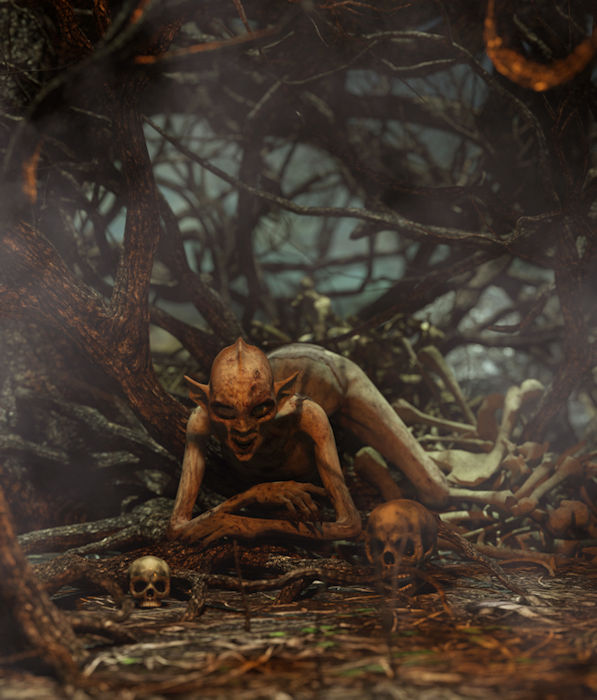Empusa – Shape-Shifting Evil Female Demon In Greek Myth And Folklore
A. Sutherland - AncientPages.com - The empusa initially appears in the mythology of classical Greece as a frightening female monster. She is a demonic vampire without a shape of its own, but with the ability to appear in many different animal guises and as a beautiful, tempting young woman.
Credit: Adobe Stock - Joeprachatree
Modern-day Greek folklore still speaks of the empusa, who enters the body of its human prey (particularly children) to consume the flesh and blood of its victim. She loves to eat young and beautiful bodies and drink their blood because it’s strong and pure.
Empusa represents the Grecian form of a vampire. In the Greek myth, this female demon is usually described as having one prosthetic leg made of brass and the other leg of a donkey; from the waist up, Empusa is a human-like creature with hideous blemishes and scars on her skin.
She was said to have been the daughter of the goddess of witchcraft, the night, moon, ghosts, and necromancy, Hekate, and was sent by her to torment people, especially travelers.
This evil creature seeks its prey, and as the shape-shifter changes its apparition into an animal or a beautiful woman. She drinks her victims’ blood and consumes their flesh (like a vampire or succubus). The monster thrives in waters and on land, so it usually dwells along the coast.
An ancient story about a 25-year-old man of Lycia, Menippus, who is intelligent, handsome, and exceptionally well-built as an athlete, relates an encounter with this evil creature. One day, as Menippus walks along the road, he is met by an apparition. Empusa appears in the guise of a Phoenician woman, and Menippus lives under her spell. He falls in love with her and plans to marry her, unaware of what she is.
Apollonius is somewhat skeptical of her; he attends the wedding and is introduced to her by Menippus of Corinth, his former student. This wealthy woman is the mistress of all the servants. Hearing this, Apollonius tells Menippus that his wonderful bride is nothing but a vampire who – like others in her race - loves to devour flesh and blood of its victims.
Apollonius of Tyana made the young woman confess her true identity, thereby rescuing Menippus from a terrible fate on his wedding night.
Menippus’ bride is offended and orders Apollonius to leave, but his words have already broken her spell, and all the gold, silver, and servants vanished.
Pretending to weep, this demonic creature begs Apollonius not to force her to confess what she is, but he does. Finally, she admits she usually chooses her offers among young and beautiful people to dine on them, and Menippus is one of them.
Belief in this evil monster persists into modern times. Present-day shepherds blame her for accidents that happen to their animals, claiming that she suddenly appears, hurts them, and disappears again. Later tales describe a whole race of these monsters - the Empusae - living on the North African coast in Libya.
The ’Empusa’ is the early Greek term for the later Latin term ‘lamia.’ Over the ages, the descriptions of this female demon changed considerably and were often confused with Lamia
Ancient people believed that the only defense against these monsters was abusing them verbally or shouting insults. As a result, they screamed and fled their way.
Except for the Greek account of Empusa, the same awful creature is known in other ancient cultures of the Mediterranean region.
Written by – A. Sutherland AncientPages.com Staff Writer
Copyright © AncientPages.com All rights reserved. This material may not be published, broadcast, rewritten or redistributed in whole or part without the express written permission of AncientPages.com
Expand for referencesReferences:
Grant M, Hazel J. Who's Who in Classical Mythology
March J. R. Dictionary of Classical Mythology
More From Ancient Pages
-
 Sinuses Prevented Prehistoric Crocodile Relatives From Deep Diving
Evolution | Nov 7, 2024
Sinuses Prevented Prehistoric Crocodile Relatives From Deep Diving
Evolution | Nov 7, 2024 -
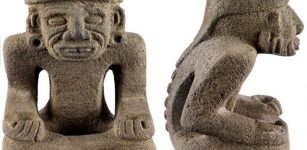 Huehueteotl: Old Aztec God Of Fire, Time And Aging – Ceremony Of The New Fire
Aztec Mythology | Jan 31, 2019
Huehueteotl: Old Aztec God Of Fire, Time And Aging – Ceremony Of The New Fire
Aztec Mythology | Jan 31, 2019 -
 10 Ancient Chinese Musical Instruments You Didn’t Know About
Featured Stories | Jan 20, 2016
10 Ancient Chinese Musical Instruments You Didn’t Know About
Featured Stories | Jan 20, 2016 -
 Samurai Swords: Katana And Wakizashi And Their Long Tradition
Ancient Traditions And Customs | Aug 6, 2018
Samurai Swords: Katana And Wakizashi And Their Long Tradition
Ancient Traditions And Customs | Aug 6, 2018 -
 Brown Hares And Chickens Were Seen As Gods Not Food In Iron Age Britain
Archaeology | Apr 12, 2020
Brown Hares And Chickens Were Seen As Gods Not Food In Iron Age Britain
Archaeology | Apr 12, 2020 -
 Underground Civilizations – Secret Subterranean Corridors And Strange People – Part 2
Civilizations | May 10, 2019
Underground Civilizations – Secret Subterranean Corridors And Strange People – Part 2
Civilizations | May 10, 2019 -
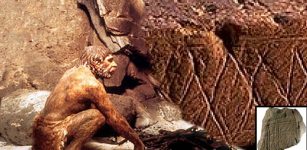 Is The Hashtag World’s Oldest Symbol And First Communication Attempt?
Ancient Symbols | Apr 27, 2018
Is The Hashtag World’s Oldest Symbol And First Communication Attempt?
Ancient Symbols | Apr 27, 2018 -
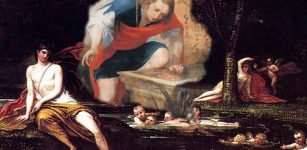 Echo And Narcissus: Cursed Ability To Speak And Punishment Of Selfish Love And Vanity
Featured Stories | Feb 9, 2021
Echo And Narcissus: Cursed Ability To Speak And Punishment Of Selfish Love And Vanity
Featured Stories | Feb 9, 2021 -
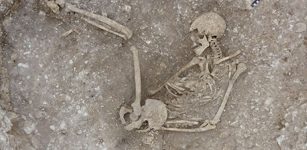 Unusual Iron Age Cemetery Discovered In Dorset, UK
Archaeology | Jul 11, 2022
Unusual Iron Age Cemetery Discovered In Dorset, UK
Archaeology | Jul 11, 2022 -
 Aboriginal People Made Pottery And Navigated To Remote Islands Millennia Before Europeans Arrived
Featured Stories | Aug 19, 2024
Aboriginal People Made Pottery And Navigated To Remote Islands Millennia Before Europeans Arrived
Featured Stories | Aug 19, 2024 -
 Cog Stones – Unusual Stone Discs Made By An Ancient Lost Civilization In California
Artifacts | Jan 4, 2018
Cog Stones – Unusual Stone Discs Made By An Ancient Lost Civilization In California
Artifacts | Jan 4, 2018 -
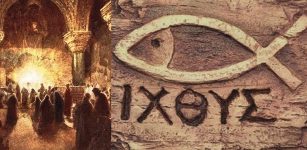 Mysterious Ichthys – Ancient Secret Christian Symbol With A Deep Meaning
Ancient Symbols | Mar 6, 2018
Mysterious Ichthys – Ancient Secret Christian Symbol With A Deep Meaning
Ancient Symbols | Mar 6, 2018 -
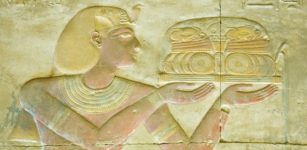 Table Manners And First Code Of Correct Behavior Were Introduced In Egypt 2,500 B.C. By Ptahhotep
Ancient History Facts | Oct 26, 2020
Table Manners And First Code Of Correct Behavior Were Introduced In Egypt 2,500 B.C. By Ptahhotep
Ancient History Facts | Oct 26, 2020 -
 Birka: Major Trading Center During The Viking Age
Featured Stories | Feb 12, 2018
Birka: Major Trading Center During The Viking Age
Featured Stories | Feb 12, 2018 -
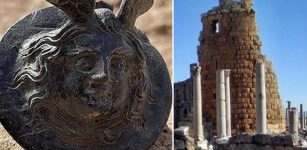 1,800-Year-Old Military Medal with Medusa Head Unearthed In Ancient City of Perge (Perrhe), Southeastern Turkey
Archaeology | Oct 11, 2022
1,800-Year-Old Military Medal with Medusa Head Unearthed In Ancient City of Perge (Perrhe), Southeastern Turkey
Archaeology | Oct 11, 2022 -
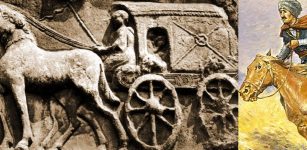 Struggle To Get Mail On Time Has Lasted More Than 5,000 Years – Part 1
Featured Stories | Jul 30, 2017
Struggle To Get Mail On Time Has Lasted More Than 5,000 Years – Part 1
Featured Stories | Jul 30, 2017 -
 Mysterious Disappearance Of The Eilean Mor Lighthouse Keepers Remains Unsolved
Featured Stories | Dec 21, 2018
Mysterious Disappearance Of The Eilean Mor Lighthouse Keepers Remains Unsolved
Featured Stories | Dec 21, 2018 -
 Discovered Roman Malting Oven Could Be Evidence Of 2,000-Year-Old Beer Production In The UK
Archaeology | Apr 4, 2022
Discovered Roman Malting Oven Could Be Evidence Of 2,000-Year-Old Beer Production In The UK
Archaeology | Apr 4, 2022 -
 Prehistoric Dispilio: Accurately Dating Ancient Site To 5259 BC Using Cosmic Rays
Archaeology | May 21, 2024
Prehistoric Dispilio: Accurately Dating Ancient Site To 5259 BC Using Cosmic Rays
Archaeology | May 21, 2024 -
 A 200-Year-Old Swedish Mystery Remains Unsolved
Featured Stories | Oct 7, 2015
A 200-Year-Old Swedish Mystery Remains Unsolved
Featured Stories | Oct 7, 2015

